搜索
Title: Dual-responsive Deformation of A Crosslinked Liquid Crystal Polymer Film with Complex Molecular Alignment
Author: Quan Liu, Yuanyuan Zhan, Jia Wei, Wei Ji, Wei Hu, Yanlei Yu*
Journal: Soft Matter, 2017, 13(36), 6145-6151
Abstract:
Crosslinked liquid crystal polymers(CLCPs) containing azobenzene mesogens have been developed as stimuli-responsive materials, which can undergo photodeformation and thus convert light energy into mechanical force. The deformation behavior of CLCPs is strongly influenced by the alignment of the mesogens; however, a precise control of the alignment domain at micro-scale is still a challenge. Here we report complex molecular alignment in the CLCP film by using photoalignment technology. First, azo dye SD1 is aligned in-plane by UV light with a discrete alternating striped director profile. The SD1 molecules inadjacent strips are aligned orthogonal, and the widths of the strips are controlled in several hundred micrometers by a photomask with grating patterns.Then the liquid crystal molecules in the CLCP film are aligned by SD1 through the anchoring effect on one side (SD1 side), and aligned perpendicular by the polyimide (PI) alignment layer on the other side (PI side). With these alignments, two kinds of splayed structures are formed through the depth of the film. When irradiated by UV light, the film bends toward the SD1 side with thebending direction along the diagonal of the film, determined by the resultant direction of molecular alignment on the SD1 side. When irradiated by blue light and heat, the bending direction is along the edge of the film. This dual-responsive deformable film with complex alignment is anticipated to beused in shape-changing biomedical devices, multiple controllable switches, and microactuators.
论文链接:https://pubs.rsc.org/en/content/articlelanding/2017/SM/C7SM01291H#!divAbstract

本研究利用光取向技术制备了具有复杂分子取向的CLCP薄膜。首先,在紫外光和条带状掩膜板的作用下,偶氮染料SD1在平面内排列。其中,相邻条带中的分子正交排列,条带的宽度由有摩擦作用的掩模控制在几百微米。然后,通过SD1在膜的一侧(SD1侧)的锚定作用使液晶基元与膜的另一侧(PI侧)垂直排列。有了这些排列,便在具有较大厚度的薄膜中形成了两种不同的展开结构。薄膜的弯曲形变可以由紫外线、蓝光和热引发。与单轴取向的展开结构的薄膜不同,由于SD1侧分子取向方向的影响,紫外光照射下薄膜沿着其对角线方向弯曲。在蓝光和热诱导弯曲下,薄膜第一次会过度回复,这可以用薄膜内部应力的释放来解释。总之,这种双响应膜在智能生物医学设备、多种可控开关和微驱动器方面有潜在的应用。








